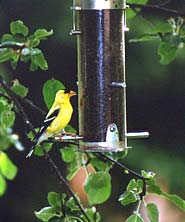Tips for Bird Feeding

Watching birds in your garden and at feeders is one of the most pleasurable ways to enjoy nature through a cold winter. On snowy days, their liveliness, colors and sounds are a source of fascination and joy. Now, with winter approaching, is a good time to set up a feeder in your garden so the birds in your area add your garden to their winter feeding rounds.
Where to Put Your Feeder
For the greatest variety and number of birds, try a variety of feeding spots and feeders. Start with one or two feeders and increase the number as you learn which foods and feeders the birds prefer. Place the feeders so you can watch them easily from a convenient window. Also, when the feeders are in sight, you'll see when they need to be filled or cleaned.
Hang feeders near shrubs or trees so birds have nearby cover and an escape route from predators such as sharp-shinned hawks. In extremely windy areas, choose sheltered locations for the feeders.
Hang feeders near shrubs or trees so birds have nearby cover and an escape route from predators such as sharp-shinned hawks. In extremely windy areas, choose sheltered locations for the feeders.
The Best Bird Seeds

Outwitting Unwanted Visitors
Squirrels are a major nemesis of bird feeders. In some areas, so are racoons and rats. Luckily, there are several types of feeders and tips about placement that will help deter visits by uninvited guests.
Squirrels
To prevent squirrels from reaching the feeder, use one that includes an attached baffle or that has a funnel-shaped top. You can also buy baffles separately and attach them to your favorite feeder. Elevate the feeder at least five feet off the ground. Place it eight to 10 feet from the nearest building and overhanging tree branches.
Raccoons
To protect post-mounted feeders from raccoons, attach a cone shield with an 18-inch radius on the post below the feeder (at least four feet above the ground). To prevent raccoons and dogs from carrying off suet, place it in a wire or mesh enclosure and hang it well above the ground.
Rats
If rats are a concern, avoid ground and platform feeders, which are most likely to attract them. Regularly clean up under hanging feeders. Lay a tarp under the feeder to catch seed hulls and dropped seed. Offer birds the seeds they prefer rather than less attractive foods such as wheat, sorghum and cracked corn, which will end up scattered on the ground. Put out just enough food so the birds clean it up before dark.
Pest Birds
If larger birds such as grackles are a problem, choose feeders designed for small birds, such as a thistle tube or hanging globe.
What About Cats?
If you have a cat, keep it inside. A bell attached to your cat's collar does little to alert birds to its approach.
Fall Cleanup and Birds
Birds have four basic needs: food, water, shelter from predators and the elements, and safe nesting places. In addition to setting out feeders to provide food, starting this fall and winter you can help birds meet their needs in the following ways.
As you clean up, leave a brush pile that birds can use for cover. Also leave seeds and fruits on plants such as sunflowers (for jays and chickadees); cosmos, chicory and evening primrose (for goldfinches); and grapes (for cedar waxwings).
Provide fresh water in a shallow container. Water should be no more than two inches deep. In winter, it is especially important to keep the water ice-free by changing it frequently or by using an immersion-type water heater designed for outdoor use.
Landscapes with abundant trees and shrubs, and a relatively small lawn, are most attractive to birds. To enhance your garden with plants that provide natural food shelter, develop a landscape plan this winter in preparation for spring planting.
Provide fresh water in a shallow container. Water should be no more than two inches deep. In winter, it is especially important to keep the water ice-free by changing it frequently or by using an immersion-type water heater designed for outdoor use.
Landscapes with abundant trees and shrubs, and a relatively small lawn, are most attractive to birds. To enhance your garden with plants that provide natural food shelter, develop a landscape plan this winter in preparation for spring planting.
Labels: bird feeding, landscape, landscaping


0 Comments:
Post a Comment
Subscribe to Post Comments [Atom]
<< Home